





Section 1. How important your thoughts are to your reality, happiness and success.
Consider the following quotes:
"I think, therefore I am." - René Descartes
"The mind is everything. What you think you become." - Buddha
"You are what you think. All that you are arises from your thoughts. With your thoughts you make your world." - Anonymous, The Dhammapada
"A man is but the product of his thoughts, what he thinks, he becomes." Ghandi
"With realization of one's own potential and self-confidence in one's ability, one can build a better world." - Dalai Lama
"Think good and good follows. Think evil and evil follows. You are what you think all day long." - Joseph Murphy
"If you change the way you look at things, the things you look at change."- Dr. Wayne Dyer
"Change your thoughts and you change your world." - Norman Vincent Peale
"Happiness is when what you think, what you say and what you do are in harmony. - Mahatma Gandhi
"Your attitude, not your aptitude, determines your altitude."- Zig Ziglar
"The brain is like a muscle. When it is in use we feel very good. Understanding is joyous." - Carl Sagan
"How am I going to live today in order to create the tomorrow I'm committed to?"- Tony Robbins
"Life is a mirror and will reflect back to the thinker what he thinks into it."- Ernest Holmes
"No pessimist ever discovered the secrets of the stars, or sailed to an uncharted land, or opened a new heaven to the human spirit." - Helen Keller
"What ever the mind of man can conceive and believe, it can achieve."- Napolean Hill
"Thoughts become things. Think good ones." - Mike Dooley
A teacher says to one of her students, "Don't you want to be like Gandhi, Martin Luther King or Mother Teresa? The young student replies, "I'm not like those people. I'm just a kid from a small town". To which the teacher replies, "If that's what you think, unfortunately that is all you will likely ever be."
"Everything is energy and that's all there is to it. Match the frequency of the reality you want and you cannot help but get that reality. It can be no other way. This is not philosophy. This is physics" - Albert Einstein
Life's what you make it!
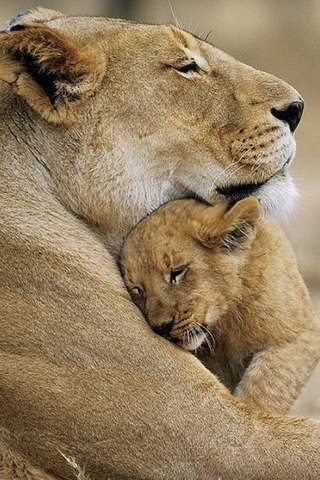
The contents of this discussion are as follows:
Section 1. How important thoughts are to our reality, happiness and success. (see quotes above)
Section 2. How understanding how our brain works will help you.
Section 3. How understanding basic human needs and wants will help you.
Section 4. Understanding how needs and wants work together with how the brain functions.
Section 5. How the socieo-economic environment you are raised in affects both your thoughts and needs.
The goal of this entire discussion is to create understanding so that we have a better chance of improving our reality, happiness and success.
Section 2. How understanding how your brain works will help you.
"Our bodies have five senses: touch, smell, taste, sight, hearing. But not to be overlooked are the senses of our souls: intuition, peace, foresight, trust, empathy, respect. The differences between people lie in their use of these senses; most people don't know anything about the inner senses while a few people rely on them just as they rely on their physical senses, and in fact probably even more." - C. JoyBell C.
What we hope to discover is how the human brain processes information and stimuli (both positive and negative) in order to create who we are so that we can learn from our understanding of ourselves and thus improve our likelihood for a more peaceful, happy and successful life.
The following is a flowchart of how the brain may process information:
Inputs: Internal and external sensations and stimuli.
Perception: Awareness of new stimuli and information, and awareness of the outcome from our behavior & actions.
Analysis: Thinking and feeling about this stimuli, information and results from our actions.
Decisions: Conclusions from analysis and formation of attitudes, beliefs and values.
Actions: The physical responses we conduct as a result from our conclusions.
Results: The outcome of our actions, both positive and negative.
All this leads back to more inputs, repeating the cycle.
To summarize this brain process:
A change in perception (awareness/intuition) leads to a change in thinking (understanding/comprehension), which leads to a change in attitude (feelings/beliefs), which leads to a change in behavior (actions), which leads to a change in reality (results).
How this relates to peace:
Peace, like reading, writing, mathematics, drawing, emotional intelligence and enlightenment ("understanding/comprehension/compassion/meditation/intuition"), are learned skills that improve our knowledge, maturity, health, happiness and longevity. Peace is probably the most important lesson we should learn during our lives and the sooner the better. The advent of the world wide web may just provide the boost in knowledge, wisdom & peace humankind has been waiting for. Improved communication may be the difference between extinction and survival. Through knowledge, Peace will evolve. Knowledge is power. Knowledge combined with Enlightenment leads to wisdom. Wisdom is Peace!
Section 3. How understanding basic human needs and wants will help you.
Maslow's hierarchy of needs pyramid
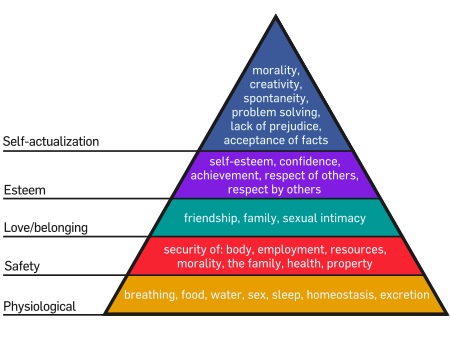
We have discussed how our thoughts and brain processes shape us and our reality. Now we need to consider how our needs / wants and our current and past environment (social-economic background) also play a huge role in creating who we are today. We all have needs and wants that cause us to take action. Our actions then lead to success or failure, which we learn from. We then repeat the process over and over for all our other needs and wants.
Needs > Wants > Tension > Action > Success or Failure > Needs & Wants
The more tension we feel, the more likely we are to take action to reduce it. According to Maslow's hierarchy of needs pyramid, our first/basic needs are "physiological": food, water, air, warmth, sleep and libido. These needs must be met for growth to occur. The next level of needs are "security" needs: protection from physical danger, financial security, health, employment and shelter. Once past these stages we move on to the "love and acceptance" needs: family, friendship, intimacy, groups and gangs, and the need to be accepted by others.

After our love and acceptance needs are met, we try to fulfill our "esteem and personal growth" needs: the need for confidence, self-esteem, respect, achievement, education, praise, power and the desire for mental, emotional and spiritual growth. If we make it past the esteem needs then we have the chance to self-actualize, something few of us have ever done. Self actualization needs include creativity, problem solving ability, morality, compassion, lack of prejudice and acceptance of facts. By self-actualizing, you fulfill your desire to become all that you are capable of becoming. You maximize your talents and share your success with the rest of the world. Some well known self-actualizers are Abraham Lincoln, Gandhi, Eleanor Roosevelt, Martin Luther King, Thomas Edison, Stephen Hawking, Nelson Mandela and Mother Teresa. As a new addition to these pyramid of needs, it has been proposed that the highest level of personal human achievement may be enlightenment and self-transcendence.
Note that at the bottom level of the pyramid there are many of us and as you reach higher levels of the pyramid, there are fewer of us that achieve these needs. We can all reach the higher levels but even those that do may have "difficiencies" in several of the lower needs levels that cause us to fall backward and slow us from reaching our potential. There is a good chance that if you are interested in obtaining inner peace and world peace, you are well on your way to attaining self-actualization and enlightenment. For this you are to be commended. Namaste.
Section 4. Understanding how needs and wants work together with how the brain functions.
Now we can tie the brain process with the Maslow's wants and needs pyramid model.
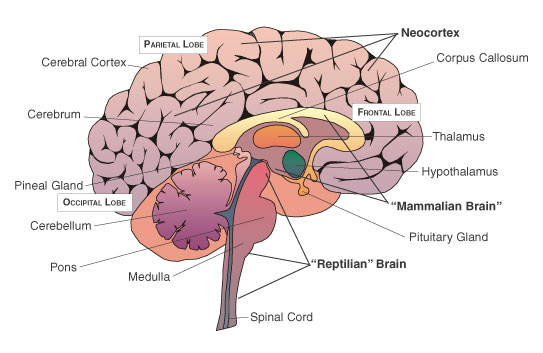
The brain is made of three overlapping sections (the Triune Brain): The Reptilian brain (brain stem / unconscious brain), the Mammalian brain (limbic system / emotional brain / subconscious brain), and the Neomammalian brain (cerebral cortex / conscious, rational brain / intellect). Each interacts and competes with the others. The cerebral cortex, which showed up in primates and humans, accounts for 85% of the total mass (2.5 pounds out of the 3 pound total). The brain stem is responsible for our basic physiological needs, involuntary body functions, territorial and survival instincts. This relates closely with the bottom level of the pyramid of needs. Its influence on our behavior is primarily instinctual and unconscious. The limbic system is responsible for higher body functions, memory and emotions. Many of the chemicals released to our body come from this section (adrenaline, seratonine, dopamine, etc..) This is directly related to the love, nurture and belonginess needs section of Maslow's pyramid of needs. Its influence on behavior comes primarily from past experience (success and failures stored in our memory). The cerebral cortex gives humans the ability for cognitive thinking, decision making, planning, creativity, intuition - the ability to think and reason. It is divide into two halves, the left: logical, verbal, analytical, business side and the right: creative, intuitive, imaginative, pictorial, musical, recreational side. You might say the cerebral cortex allows us to reach the higher levels of the pyramid of needs. Its influence on behavior in primarily based on our education, training / conditioning, reasoning and intuition.
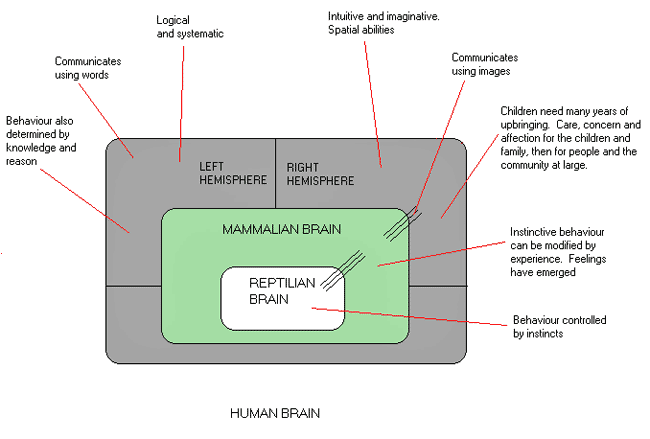
One of the keys to happiness is to learn how to use our left and right brain together to create balance. The left (logical) brain must "partner" with the emotional/intuitive right brain. By looking at this "vase-face" picture, you can feel the shift from left (vase) to right (faces), and back again.

A few quick ways to shift to the right (creative/intuitive brain) is to meditate, observe flowers, enjoy artwork or play with children (enjoy time), start humming or singing, listen to music, enjoy the company of friends, family or animals, or start drawing, photographing, or painting. A few quick ways to shift to the left (logical brain) is to look at your watch (recognize time) or perform mathematics in your head. Those that spend all their time predominantly in one hemisphere (unless they are very well trained.) are very likely to have mental, financial, and/or emotional problems. Only by utilizing the two halves together can we hope to rise above the mind and attain the wisdom which will lead us to peace, happiness and joy. Notice how it all starts with one step after another? First we must understand, comprehend, and utilize the mind and perhaps soon after we have a chance to rise above our egos and free ourselves from anger, fear, pain, suffering and confusion. Who among us doesn't want understanding and enlightenment!
The Elephant and the Rider

Although it may seem that we are what we think, and that the intellect (rational, conscious brain) is more powerful than the emotional, subconscious brain, it is the combination of the two that have the greatest impact on affecting our reality. A good metaphor of this is the elephant and the rider, created by Buddha and expanded on by Jonathon Haidt in his book, "The Happiness Hypothesis: Finding Modern Truth in Ancient Wisdom". Buddha described the mind as a wild elephant, who will do as it pleases. Plato also used a similar metaphor, describing the soul as a chariot and the rational part of the mind as the charioteer, who must control the chariot.
The rider is our intellect and the 6 ton elephant is our emotional brain. The rider may think they are in control but if the elephant decides to take control, there is little the rider can do about it. We may think we are in control most of the time, but often it is our emotions, our subconscious that causes us to make decisions and has a significant, if not dominant affect on our behavior. This is not to say that this is good or bad, just that we need to be aware of what is going on in our three-part brain. It is likely that the best chance for us to positively affect our reality is when we use our intellect and become consciously aware of our emotional brains' influence in order to create a powerful synergy.
Respond vs React
In relation to our behavior, when you rely only on the emotional brain, you tend to "react" to situations, many times with negative results because you did not think things through. When you utilize the combination of the intellect and the emotional brain, you tend to "respond" to situations and events, giving yourself a better chance for a positive outcome. The emotional brain / limbic system has three dominant sections: The hippocampus (memory), the hypothalamus (homeostasis), and the amygdala (memory based reactions to stimuli).
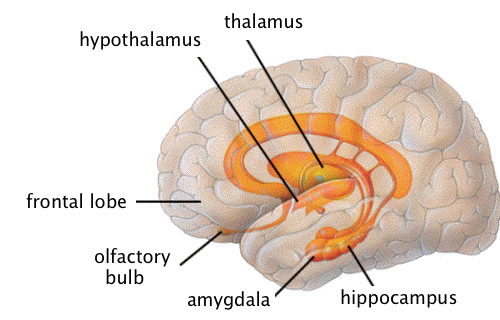
The hippocampus consists of two “horns” that curve back from the amygdala. It appears to be very important in converting things that are “in your mind” at the moment (in short-term memory) into things that you will remember for the long run (long-term memory). If the hippocampus is damaged, a person cannot build new memories, and lives instead in a strange world where everything they experience just fades away, even while older memories from the time before the damage are untouched!
The amygdalas are two almond-shaped masses of neurons on either side of the thalamus at the lower end of the hippocampus. In humans and other animals, this subcortical brain structure is linked to both fear responses and pleasure. Its size is positively correlated with aggressive behavior across species. When it is stimulated electrically, animals respond with aggression. And if the amygdala is removed, animals get very tame and no longer respond to things that would have caused rage before. But there is more to it than just anger: When removed, animals also become indifferent to stimuli that would have otherwise have caused fear and even sexual responses. The amygdala plays a key role in the processsing of emotions and the transfer of these emotional events into long term memory for use in dealing with similar events in the future.. The amygdala may be termed as the "modern" fight or flight mechanism, as opposed to the unconscious mechanism of the instinctive reptilian brain. It is the "reactionary" action of the elephant (emotions) as opposed to the "respond" action of the rider (intellect). Perhaps you have heard the phrase "amygdala hijacking"? It is where 15 seconds can harm the rest of your life. By reacting strongly to extreme emotions we can make rash decisions and do and say things that can get us into big trouble. Hopefully by being aware of this experience of "seeing red", we can learn to step back from those situations until we can decide on an appropriate "response" that creates a better outcome than would have happened by reacting.
A division in the brain which is analogous to the elephant and rider metaphor is that between controlled processes and automatic processes. Automatic processes are those mental processes that occur automatically without our conscious control. Most of our mental processes are automatic. Controlled processes are those processes that require conscious effort, thus can only be done one at a time. Automatic processes developed as the brain evolved and became more and more efficient. Controlled processes however, evolved only after language developed as planning and analyzing different choices requires words. Since they have not evolved as much as automatic processes, they are not as perfect. Haidt compares these two processes to the rider and the elephant. The rider (controlled processes) developed to attend to the elephant (automatic processes). The elephant is responsible for quick and hopefully dependable actions, while the rider advices the elephant and helps make better choices, but cannot order the elephant to do something. In fact, if the elephant, which also consists of gut feelings, emotions, beliefs and memories, does something inexplicable, the rider makes up a story to explain the behavior. The rider has evolved to serve the automatic processes of the elephant. It can see into the future and advise the elephant on choices. It is also a storyteller and creates stories to justify the actions of the elephant. Often these are stories that we not only tell ourselves, but also share with the world. Storytellers can learn from each other and contribute to each other’s stories. These stories shape the sort of people we become and the world we create.
"This thing up here, this consciousness, thinks it's running the shop. It's a secondary organ. It's a secondary organ of a total human being, and it must not put itself in control. It must submit and serve the humanity of the body." - Joseph Campbell
The Maharishi Effect - Does Mass Meditation Work?
In 1975, Maharishi inaugurated the dawn of a new era, proclaiming that 'through the window of science we see the dawn of the Age of Enlightenment'. Scientific research found that in cities and towns all over the world where as little as one per cent of the population practices the Transcendental Meditation Technique, the trend of rising crime rate is reversed, indicating increasing order and harmony. This phenomenon was reported in a paper published in 1976. The finding was that when 1% of a community practiced the Transcendental Meditation program, then the crime rate was reduced by 16% on average. Research scientists named this phenomenon of rising coherence in the collective consciousness of the whole society the Maharishi Effect.
The Maharishi Effect establishes the principle that individual consciousness affects collective consciousness.

Freud's Id, Ego and Super-ego & the Triune Brain
To further help explain the power of the Triune Brain, it is helpful to discuss Freud's Id, Ego and Super-ego model (see Wikipedia).
The Id and the Reptilian brain are very closely related. The Id is made up of our instinctive drives and impulses, our libido, our survival needs. The Id wants immediate satisfaction and self-gratification and has little to no concern for the wants and needs of others. The Id is based on the Pleasure Principle - pleasure above all else. The mind of a newborn child is regarded as completely "id-ridden". The Id remains throughout our lives and exerts a powerful, unconscious influence on our behavior.
The Ego acts according to the Reality Principle, i.e. it seeks to please the Id's instinctual drives in realistic ways that will benefit in the long term rather than bringing grief and failure. In infancy and early childhood, the Id rules behavior by obeying only the pleasure principle. In the Ego, maturity is learning to endure the "pain" of deferred gratification, when reality requires it; thus Freud proposed that “an ego thus educated has become ‘reasonable’; it no longer lets itself be governed by the pleasure principle, but obeys the reality principle, which also seeks to obtain pleasure, but pleasure which is assured through taking account of reality, even though it is pleasure postponed and diminished”. The ego comprises the organized part of the personality structure that includes defensive, perceptual, reality testing, judgment, intellectual-cognitive, synthesis of information, memory and executive functions. Conscious awareness resides in the ego, although not all of the operations of the ego are conscious. The ego separates out what is real. It helps us to organize our thoughts and make sense of them and the world around us. The ego is that part of the id which has been modified by the direct influence of the external world. The ego represents what may be called reason and common sense, in contrast to the id, which contains our passions. Thus the Ego is partly related to the emotional brain because it exerts force on our behavior through learned experiences and feelings, but also uses rational thought and reasoning from the intellectual brain, both in support and in conflict with their relationship to the Id. The Ego may be considered to be 1/2 in the conscious brain, 1/4 in the subconscious brain and 1/4 in the unconscious brain.
The Super-ego aims for perfection. It comprises that organized part of the personality structure, mainly but not entirely unconscious, that includes the individual's ego-ideal (an image of the perfect self towards which the ego should aspire), spiritual goals, and the conscience that criticizes and prohibits our drives, fantasies, feelings, and actions. The Super-ego can be thought of as a type of conscience that punishes misbehavior with feelings of guilt. Taken in this sense, the super-ego is the precedent for the conceptualization of the inner critic as it appears in contemporary therapies. The arrival of the super-ego can be described as a successful identification with parental figures, while as development proceeds the super-ego also takes on the influence of those who have stepped into the place of parents — educators, teachers, people chosen as ideal models.
According to Freud, the Ego is responsible for getting the Id and the Super-ego to work in harmony. The super-ego's demands often oppose the id’s, so the ego sometimes has a hard time in reconciling the two. The super-ego strives to act in a socially appropriate manner, whereas the id just wants instant self-gratification. The super-ego controls our sense of right and wrong and guilt. It helps us fit into society by getting us to act in socially acceptable ways. Freud's theory implies that the super-ego is a symbolic internalisation of the father figure and cultural regulations. The super-ego tends to stand in opposition to the desires of the id because of their conflicting objectives, and its self-rightous attitude towards the ego. The super-ego acts as the conscience, maintaining our sense of morality and stopping us from violating social and cultural taboos.
The iceberg metaphor is a commonly used visual when attempting to relate the ego, id and super-ego with the conscious and unconscious mind. In the iceberg metaphor the entire id and part of both the super-ego and the ego would be submerged in the underwater portion representing the unconscious mind. The remaining portions of the ego and superego would be displayed above water in the conscious mind area.
In summary: The ego is rational, the superego is committed to the rules of society and the id is the instinctual drive for pleasure and survival. Haidt describes their interaction as that of a horse and buggy in which the ego is the driver trying to control the noncompliant horse and the superego is the father of the driver informing him about what he is doing wrong.
Section 5. How the socieo-economic environment you are raised in affects both your thoughts and needs.
Socio-Economic Backgound
Lastly, we need to consider how our environment helps determine what we have become today. Depending on the society and economic well-being of the environment you grew up in, this will have a large influence on where you are on the wants and needs pyramid. Those that were raised in poverty stricken or war-torn regions will likely have different issues than those how grew up in wealthy or peaceful environments. That is not to say that happiness is more likely in a wealthy environment than a poor environment. No, if you look at the needs pyramid closely you may realize that love and belonginess have a big impact on our happiness and security. Those with strong emotional ties to an intimate special loved one, family, friends, and/or religious groups, may well be the happiest people on the planet, regardless of their dominant position on the pyramid of needs or socieo-economic background. What is important to note may be that those that do reach the higher levels of the pyramid may almost be "obligated" to help those at the lower levels in order for the world to have a chance at world peace. Are we our brothers keeper? You may have heard the phrase, "With great power comes great responsibility" . Maybe when it comes to world peace, it is one of the phrases that helps makes peace a reality.

Here is a real world example combining many of the concepts discussed above:
A 15 year old girl from Pakistan named Malala Yousafzai, decides to stand up for the right of girls in her region to get an education. Saturday, November 11, 2012 marked one month since Malala was attacked by the Pakistani Taliban for promoting girls' education and criticizing the armed group.
Her actions caused Taliban militants to decide to kill her for her beliefs and actions. A Taliban fighter's bullet grazed Yousufzai's brain and she is now recovering in a hospital in Britain.
The results of these individuals actions are this (so far):
Earlier this week, the United Nations declared November 10 "Malala Day" in honor of the Pakistani human rights campaigner and peace activist, who was shot in the head by the Taliban last month in northern Pakistan.
About 100 countries have commemorated United Nations "Malala Day" to honor Malala Yousafzai.
On Saturday, November 11th, events were held in Pakistan, Afghanistan, India, the United States, Britain, Canada, Australia, Mexico, Sierra Leone and many other countries.
In the days following the shooting, Yousafzai became an international icon and world leaders pledged to support her campaign for girls' education.
On Friday, Pakistani President Asif Zardari added his signature to petitions signed by more than one million people urging Pakistan to pay stipends to families who put their girls in school in honor of Malala. "Malala's dreams represent what is best about Pakistan," said Gordon Brown, former UK prime minister, as he presented the petitions to Zardari.
The families of more than three million poor children in Pakistan will receive cash stipends if their children go to school, the government has said, honoring the first-ever "Malala Day" in support of a schoolgirl shot by the Taliban.
A separate online petition calling for Yousafzai to be put forward for the Nobel Peace Prize has attracted nearly 90,000 signatures and campaigners urged British Prime Minister David Cameron to recommend her for the award.
In October 2014, Malala was awarded the Nobel Peace Prize.
This just shows how much the perceptions, thoughts, beliefs and actions of ordinary people can change reality.
Once again, in conclusion:
A change in perception (awareness/intuition) leads to a change in thinking (understanding/comprehension), which leads to a change in attitude (feelings/beliefs), which leads to a change in behavior (actions), which leads to a change in reality (results).
Life's what we make it!
A wise person creates a harmony between the head, the heart, and the body. In this harmony comes the revelation of the source of one's life, the very center, the soul. - OSHO
 .
. .
. =
= 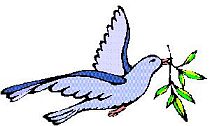
Last update: April 29, 2016
Posted to the web on November 21, 2012